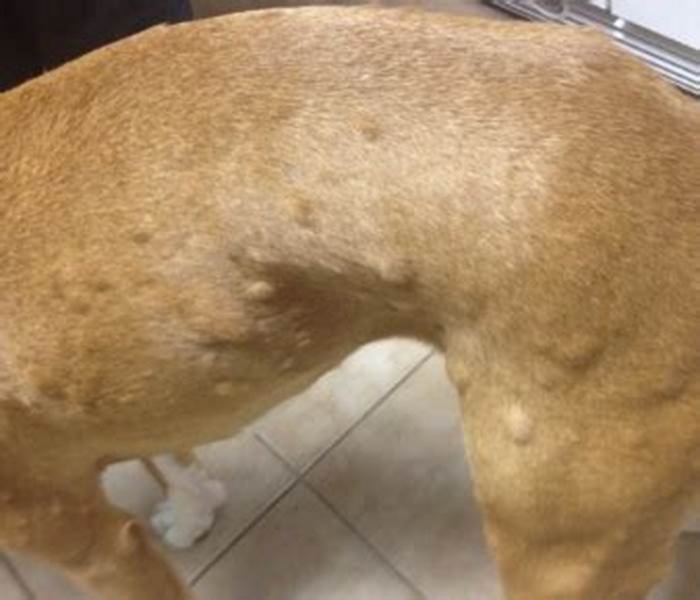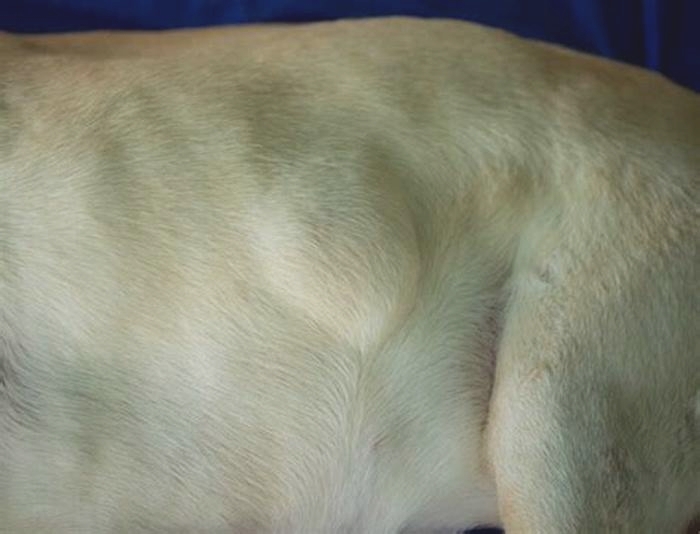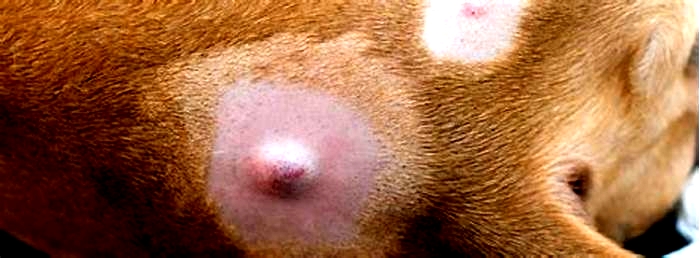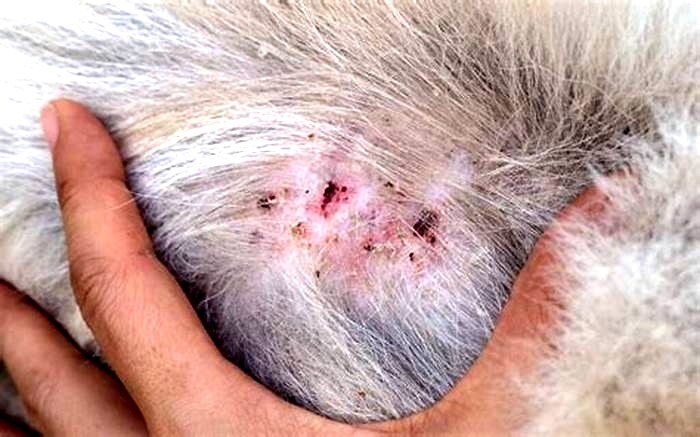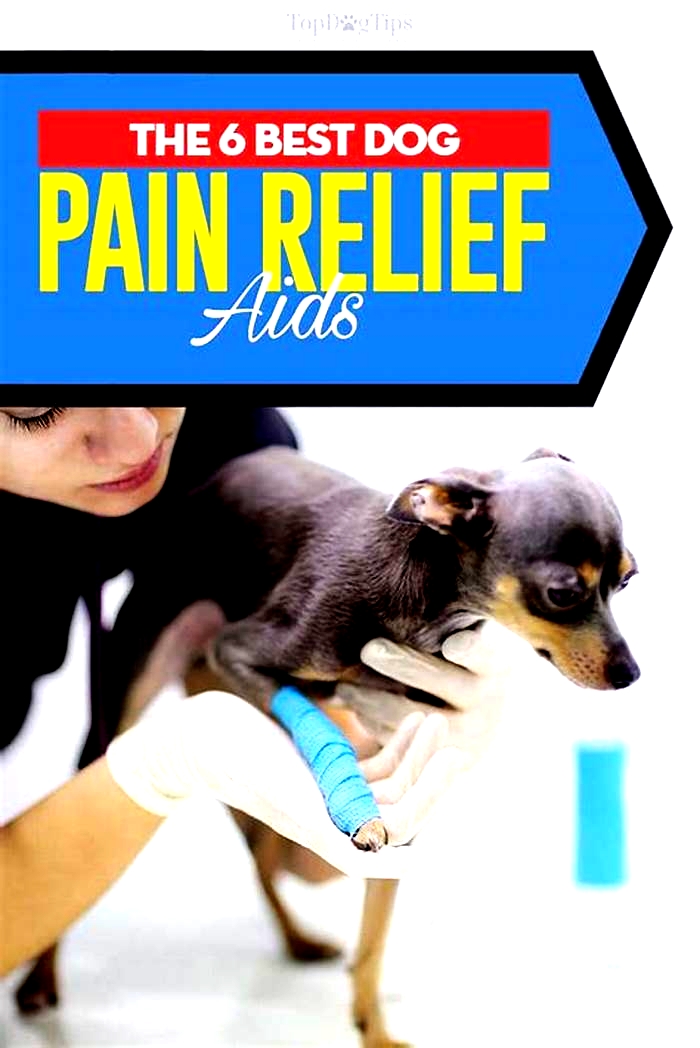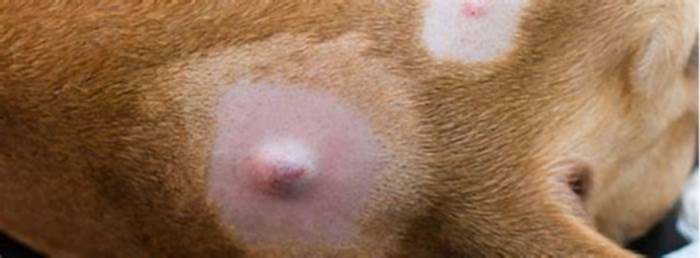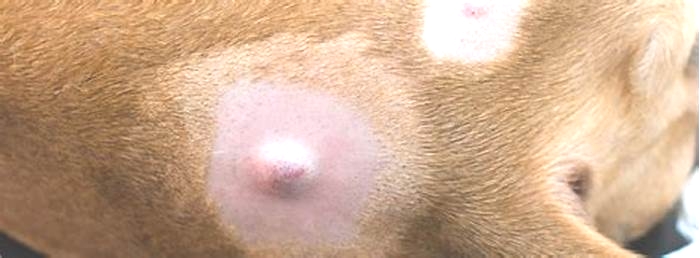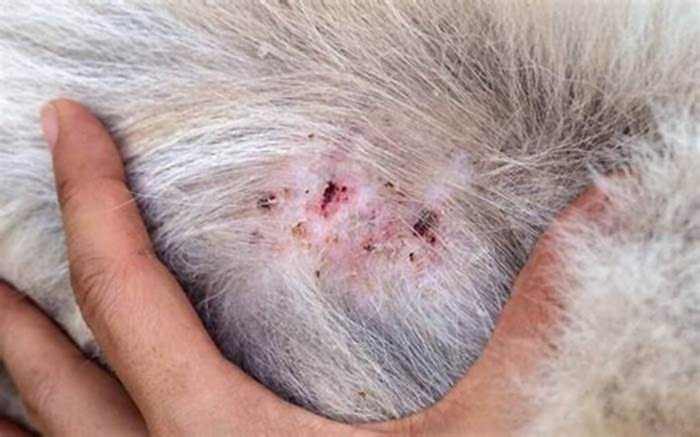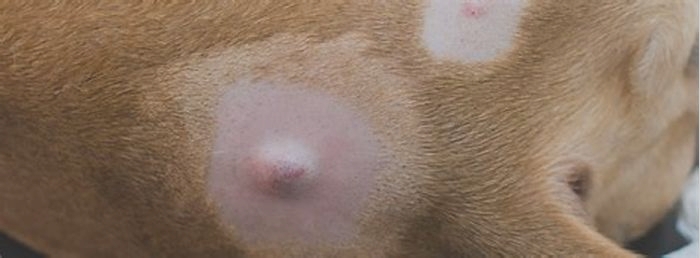Why does my dog have big bumps all over
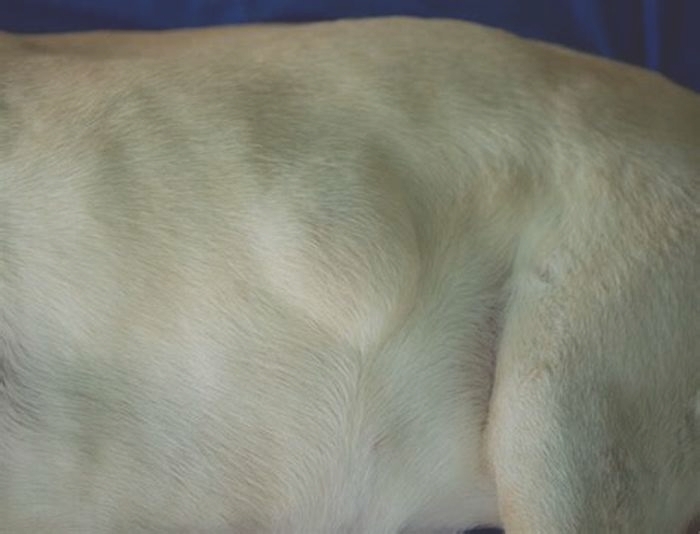
Dog has Bumps All Over His Body Top Reasons Why
Dog has Bumps All Over His Body Top Reasons Why
Youre all cozied up on the couch one night with your beloved pet. Then, you stroke the fur on his back side and feel several bumps.
Upon closer inspection, your dog has bumps all over his body! If this is a familiar scenario to you, the bumps that you felt might just be hives. Not to worry, though, because they can easily be treated.
What Do Hives Look Like in Dogs?
Hive are basically localized patches of pale-red, inflamed, itchy bumps. Also known as urticaria, it is uncommon in dogs, but its still possible for your canine to get it as a negative reaction to insect bites or stings, shampoos, and certain medicines.
These bumps can vary in size, from small pin-sized dots to large red patches. On dogs, they can appear anywhere on the body but, most of the time, you will see them on his back or neck. They may also appear in areas that are more sensitive like the lips, tongue, or ears.
Because hives appear as raised round bumps on the skin, they will be more prominent on dogs with shorter fur compared to dogs with a longer one. So, its best to do a close-up inspection if you have a breed of dog with a thicker coat.
Whats the Difference Between Hives and Rashes?
Since a rash is essentially an irritated area of the skin, you can consider hives as a kind of rash. When you press on one of the bumps, it will usually blanch up, meaning that it will appear white when pressed.
A rash can remain on the skin, as is, for several days. But, hives, on the other hand, appear suddenly (approximately a half-hour after the affected dog has been exposed to an allergen). Hives can disappear all on their own but have the tendency to reappear in different forms and on a different part of the body.
Common Reasons Why Your Dog Has Bumps All Over His Body
Anything your dog is hypersensitive to can cause hives. If he was stung by an insect, more commonly bee stings and spider bites, hives can appear. Also, if your dog ran through poison ivy, oak, or grass with pesticides, he can also get hives. In some cases, hives can appear after your dog gets vaccinated. They can also come out when your dog has certain food allergies.
In addition, because hives is a form of allergic reaction, you may also notice other symptoms. When your dog has been exposed to something that he is hypersensitive to, his face or eyes will likely be puffy, and his nose may start to become runny.
How Do You Get Rid of Bumps on Your Dog?
The best treatment is the right does of antihistamines or steroids. If this is your dogs first time to get hives, its best to visit your vet and ask about the right dose of anti-allergy medication. You should never administer Benadryl at home, by yourself, when you have not gotten instructions from your vet yet.
On the other hand, fur parents whose dogs have already gotten hives before, you may not need to visit your vet anymore since you already know the medication to give and the exact dose calculated for your pet.
Preventing Your Dog From Getting Bumps All Over His Body
In general, hives can be prevented by avoiding allergens. Always take note the of the possible causes. It will be very easy to tell since hives appear immediately. For example, take note of the brands of kibble he is allergic to. If theres a beehive in the park, steer clear of it when you are walking your dog.
It cant totally be totally avoided, when you have an adventurer on your hands. But, just make sure that you already know the right medication to administer when the next episode of hives happens.
Disclaimer: The content is not intended to be a substitute for professional veterinarian advice, diagnosis, or treatment. Always seek the advice of a veterinarian when in doubt.
Boxer Lumps, Bumps And Other Skin Problems (And Solutions)
Boxers can suffer from a variety of skin problems, most of which can be traced to shortcomings in the diet and general care.
Skin conditions in Boxer dogs range from skin tags, dryness and rashes to cysts, mange and mast cell tumors.
Identifying irregularities in your Boxers coat is an important part of taking care of your Boxers skin, as is understanding the likely cause and how to fix it.
Are Boxers Prone To Skin Conditions?
A healthy Boxer will have a glossy, smooth coat and healthy, hydrated skin.
Boxers are often regarded as being prone to skin problems, with owners frequently having vets check their dogs over for various lumps and bumps the greatest fear being mast cell tumors.
However, most of these skin issues arise in kibble-fed Boxers, and in Boxers subjected to other practices like chemical deworming, flea and tick treatments and overvaccination.
Another cause of skin issues like itching in Boxers, is an overzealous bathing schedule a bath four times a year is plenty.
(Overwashing your Boxer will strip oils from the coat, leaving the skin prone to microfissures or tiny cracks that create itch.)
All of which means that the Boxers reputation for being predisposed to skin problems neednt necessarily apply to your Boxer if you raise him right.
We shall address the common skin complaints in Boxers before talking about the number one underlying cause and how to resolve it so your Boxer can enjoy the skin hes in.
Why Does My Boxer Dog Have Bumps All Over?
Boxer dog skin bumps which come up suddenly are usually hives.
Hives are a rash of raised welts caused by some kind of toxic exposure.
While hives and facial swelling are the classic signs of bee sting in Boxers, there are a range of other causes of hives that owners frequently overlook.
Hives may occur in reaction to:
- Vaccines
- Kibble
- Flea and tick pills
- Chemical dewormers
It also happens as a result of indoor air pollution.
In other words, your Boxer may have inhaled any number of household chemicals such as:
- Cleaning sprays
- Scented plugins
- Fabric deodorizers
- Aerosolarized personal care products e.g. hair spray, perfume
Boxer Dog Lumps
Boxers may also get lumps that come up more slowly, present as singular swellings and grow larger.
These lumps are worth getting checked by a vet, ideally one experienced with Boxers.
If theres any doubt, a fine needle biopsy may be done to examine the cells under a microscope and rule out anything sinister that requires excision.
Lumps look frightening but can have simple explanations including:
- Swollen salivary glands which can cause lumps in the cheek and jaw region
- Benign fatty skin tumors called lipomas which can occur anywhere throughout the body
Boxer Dog Cysts
Cysts are swellings that frequently present between a Boxers toes or on the paw pads (but can occur anywhere).
Most cysts are benign and will clear on their own, without intervention, in a relatively short space of time.
One way of understanding benign cysts is as pockets of waste that the body hives off in one spot when its dealing with a high toxic load, parking noxious substances in one place to spare the rest of the bodily environment.
This is why cysts frequently arise when the body is detoxing after a course of medication, or when the diet is changed from kibble to raw.
The lightened toxic load and improved internal conditions trigger the body to mobilize a backlog of wastes that have been stored in fatty tissue.
This influx of toxins can overwhelm the capacity of the livers detoxification pathways.
In response, the body creates a cyst to take the wastes out of circulation until such time as the body can process them.
Eventually the cysts go down as the wastes are gradually processed.
Alternatively, cysts of this kind may break open to the surface, expelling their contents.
Here is a description of a paw cyst in a Boxer dog (my own Boxer) which arose after a course of prednisone and antibiotics and cleared within weeks, without veterinary intervention.
Boxer Dog Skin Tags
Skin tags in Boxers are small flaps of skin, usually no more than a few millimeters.
These growths may look unsightly but pose no threat, other than possibly catching on things.
When contemplating surgery for benign skin lumps, its always worth balancing the risk inherent in anesthesia and the stress of the procedure against the need for the intervention and the benefit that will flow to your Boxer.
Owners of senior Boxers must consider whether they are putting their dog under the knife for purely asthetic reasons that have no bearing on quality of life.
Opt for a local anesthetic wherever possible and remember no Boxer should ever receive the common veterinary sedative Acepromazine as a pre-anesthetic agent.
Boxer Dog Skin Allergies
Skin allergies in Boxers are a diagnosis du jour to explain symptoms like itchy skin.
However, from a holistic perspective allergies often amount to a misdiagnosis of what is really something called toxic accumulation.
Toxic accumulation producing allergies can be caused by kibble feeding, chemical ingestion or even something as seemingly minor as fat overconsumption/overfeeding.
Every kibble-fed dog will be eating more fat than is optimal.
Dogs are evolutionarily adapted to eating lean game meats, not farmed livestock that are deliberately fattened for slaughter.
There is no biological precedent for the current level of fat consumption in the average pet Boxer.
As well as itching, other signs of fat overconsumption include:
For a more fulsome exploration of how so-called allergies in Boxers arise, hit the button below.
Food Allergies
Many Boxer owners have been told their dog has a food allergy or often multiple allergies to the point that they can scarcely find a single protein the dog is clear to eat.
And so the hunt for novel proteins and the wild goose chase of elimination diets begins.
Often it culminates in medicating the dog for the rest of its natural life, at great expense.
In reality, true food allergies are rare in dogs.
The Allergy Industry
Allergy testing often through the mail using saliva and hair sample is a lucrative industry.
Then there is the pharmaceutical bonanza that is the prescription of various drugs to treat canine allergies.
Since its launch in 2014 as the latest anti-allergy med, Apoquel has surpassed flea and tick drugs to become the top-selling product in the US animal health industry.
So, allergies are big business.
There are a lot of powerful interests invested in your Boxer receiving a diagnosis of allergies.
The third element of this trio of forces pushing the allergy bandwagon is the speciality of veterinary dermatology.
Vet dermatologists are enjoying a boom not unlike that delivered to veterinary dentists by owners failing to feed their dogs raw meaty bones.
The allergy train keeps Boxers and their owners stuck on a constant medicated merry-go-round of Benadryl, Cytopoint shots, Apoquel pills and prednisone with a cascading series of drug side effects that often turn out to be much more serious than the original reason for which the medication was begun.
Owners typically see temporary symptom suppression but then a return of itching.
There is never any identification of, or resolution, of the true underlying problem staring them in the face.
The good news is its within their power to fix without paying a single vet bill.
The solution?
A proper canine diet and optimisation of basic care, as explained later in this article.
Seasonal Allergies
Seasonal allergies are another common red herring.
Dont accept a diagnosis of seasonal allergies or grass allergies until you have optimized the diet and care as described later in this article.
Only then will you see whether you really have a problem.
Your Boxer may very well be having a normal reaction to:
- Inappropriate diet
- Ingestion of substances that dont belong in a dogs body
Boxer Dog Skin Rash
Occasionally Boxers will get minor, passing rashes as a result of contact with an irritant such as some scratchy grass or a dog bed washed using fragranced laundry chemicals.
This may be the likeliest explanation if your Boxer has a red rash on his belly.
More persistent redness and inflammation may tie in to the skins role in detox, as outlined in the previous section on allergies.
Boxer Dog Red Chin
A red and irritated chin with bumps, sometimes containing pus, is usually a case of Boxer dog acne.
In some Boxers redness around the mouth may be due to irritation from plastic bowls.
However, the cause is more often systemic i.e. look at whats going in the bowl and youll find its something processed, or something containing too much fat, or just plain too much food (overfeeding).
Again, a properly composed fresh, raw diet clears the problem right up.
Boxer Dog Skin Irritation
Skin irritation in Boxers can be due to yeast overgrowth.
Yeast is another complaint frequently tackled too late in the causal chain by conventional vets.
The typical response is to dose with an antifungal (either topical or systemic) to kill the yeast rather than identifying the cause and resolving the problem at its source.
What is the cause?
Yeast feeds on whats on the skin i.e. excreted metabolic wastes, oils etc.
This single celled fungus occurs in small amounts on healthy skin.
Like any organism, it can only overgrow when there is an excess of food to sustain i.e. metabolic waste, as seen when an overloaded body is using the skin to push out toxins.
Whenever the body has gone out of balance, diet and other inputs are both the cause and the solution.
Note, yeast is responsible for that other common Boxer dog complaint: paws that smell like corn chips.
Boxer Dog Mast Cell Tumors
Boxers are said to have a genetic predisposition for developing mast cell tumors, though the genes involved are unknown.
MCTs are cancers of the immune system that can cause damage by the release of biologically active chemicals called histamines.
Mast cell tumors can be benign or aggressively malignant, spreading to other parts of the body.
While most Boxer owners know about MCTs and the need to have strange lumps checked in a timely fashion, few are aware that mast cell tumors are among the diseases made more common by neutering/spaying a Boxer.
Boxer Dog Histiocytoma
Histiocytomas are an unsightly but relatively benign skin masses or tumors that the Boxer breed can be prone to.
Histiocytomas are generally:
- Seen in young dogs, usually less than six years but as young as eight weeks
- Fast growing
- Solitary
- Button-like in appearance
- Hairless lumps
- Prone to ulceration and bleeding
- Found on the head, neck, ears or limbs (but can occur on any body part)
- Spontaneously resolving within two to three months
Note that histiocytomas are different to a range of other much more serious disorders that can affect these skin cells called histiocytes, such as malignant histiocytosis and histiocytic sarcoma.
Why Does My Boxer Puppy Have Bald Spots?
Hair loss in Boxers, if it occurs in patches on the flanks, may be a condition called seasonal flank alopecia.
Mange (see below) is another problem that can cause bald spots, particularly in pups.
Skin Discoloration
Alopecia is sometimes accompanied by a skin color change or darkening.
A blackening of the skin may also occur as part of a skin condition called calcinosis.
Calcinosis cutis, and the related but slightly different form of the disease called calcinosis circumscripta, are known to be among the many devastating side effects caused by the immunosuppressant drug prednisone.
Here is what an 11-month course of prednisone did to my 18-month-old Boxers skin and other organs.
Calcinosis involves the laying down of calcium phosphate in the skin and subcutaneous tissue, with lesions and distinctive chalky discharge.
In calcinosis cutis, the lesions typically begin on the back of the neck and spread down the back.
In calcinosis circumscripta, the calcium phosphate is laid down in lumps on bony prominences like the shoulders, elbows and tail but the tongue is another classic site for these lesions to appear.
Why Does My Boxer Have Dry Skin?
Dry skin in Boxers will ordinarily not occur if the diet is right.
Raw diets are super hydrating, and will support skin health.
Dry cracked noses in Boxers usually reflect the diet and can be resolved by proper feeding, without the need for nose butters and other creams which are invariably licked off and consumed.
Boxer Dog Ingrown Hair
Ingrown hairs can lead to swelling of the hair follicle and pus formation.
It is often possible to free the hair with some tweezers, allowing the wound to dry out and heal.
Boxer Dog Mange
Boxers, like any dog breed, can suffer from a skin mite infection called mange, which causes intense itching.
Mange comes in several different forms, of varying severity.
Demodectic Mange
Demodectic mange typically develops in puppies with deficient immune systems.
All dogs host a small population of Demodex mites that live in their hair follicles and cause no problems.
Only in individuals with disordered or suppressed immune systems does the mite population explode, resulting in demodectic mange.
Symptoms may include:
- Itching
- Hair loss
- Bald spots
- Scabbing
- Skin sores
Mange is often localized to the face and the lesions usually clear up on their own as the pups immune system rights itself.
There are two other forms of demodectic mange generalized and pododermatitis, which affects the feet.
These are tougher to resolve.
Sarcoptic Mange
Theres yet another kind of mange called sarcoptic mange, caused by the scabies mite.
The scabies mite prefers hairless skin so you may see it first on your Boxers elbows, armpits, ears, chest, belly or groin.
Unlike demodectic mange, sarcoptic mange is highly contagious including to humans.
Note that conventional treatments for mange involve dipping the dogs whole body in a powerful chemical pesticide with the risk of serious side effects including tremors.
Holistic vets may be able to offer less toxic alternatives.
Dermatitis In Boxers
Boxer dog skin issues are sometimes broadly referred to as dermatitis or atopy.
Its not just the diet of the dog in question that influences the likelihood of developing skin problems.
Diets effect is so powerful as to be intergenerational.
The main finding of a Swedish study focussed on Boxers, Bull Terriers and West Highland White Terriers was that feeding a noncommercial, home prepared diet to a mother dog during lactation had a protective effect on the pups, reducing their risk of developing atopic dermatitis.
Researchers found the odds of developing skin problems were twice as high among offspring from dogs eating processed, commercial diets.
Boxer Skin Cancer
Skin cancer is something to guard against in white Boxers or Boxers with white markings, particularly on the face.
Avoiding exposure to harsh sun is the best prevention.
Management and supervision is recommended over application of sun screens as they usually only end up ingested by the dog.
Toxic Accumulation: The Real Cause Your Boxers Skin Problems
Toxins accumulate in the body via a stacking effect.
A healthy dog can tolerate one or two or three, but will begin to show symptoms when the toxic load becomes too heavy.
A properly fed Boxer, with a chemical-free body is able to effectively process and excrete toxins encountered via incidental exposures like weedkiller on grass they sniff (and roll on at the park and absorb through their paw pads) or chemicals sprayed in the home.
Consider, however, the situation of a Boxer that receives:
- A daily influx of toxins via contaminants in kibble
- Monthly doses of dewormer chemicals
- Monthly flea and tick treatments
- A regular schedule of vaccines and booster shots (despite well-established evidence a single puppy shot provides life long immunity and the ability to titer test to prove it)
For a toxed up Boxer like this, any additional toxic exposure is liable to tip the system over the edge.
The skin including the paws, ears and eyes is typically the first place where a toxic overburden shows up.
Thats because the body enlists the skin to rapidly expel toxins and acidic metabolic wastes, which irritate the dermis and the hair follicles. UTI-like symptoms, diarrhea and mucus in a Boxers poop are other common signs of a major detox effort, as toxins inflame the tissues of the urinary tract and the bowels on their way out of the body.
How To Treat Skin Problems In Boxer Dogs
Successful resolution of skin problems in Boxers is often more a matter of what you remove than what you add.
Optimizing the diet and other aspects of care is the absolute first step.
If done properly, as described below, this will usually resolve the problem and avoid the need for medication.
Boxer Dog Diaries is reader-powered. If you make a purchase via a link I share, I may receive a small commission, at no extra cost to you.
Boxer Dog Skin Care
You can set your Boxer up for good skin health by:
- Feeding a fresh, natural raw meaty bone-based diet
- Using natural parasite control instead of wormers and flea and tick treatments
- Fasting your Boxer to support the livers detoxification function
- Avoiding medicating your Boxer unless all other avenues have been tried and failed
- Following an appropriate vaccine protocol for Boxers that is tailored to your individual dogs needs including the risk of actual exposure to the viruses being vaccinated against and makes use of titers
Give Your Dog a Bone: The Practical Commonsense Way to Feed Dogs for a Long Healthy Life by Australian vet and raw feeding pioneer Dr Ian Billinghurst is a great read for understanding the power of feeding a fresh, natural canine diet.
Remember that skincare in Boxers takes in the paws, ears and eyes which are the canaries in the coal mine in terms of being the body parts that show the first signs that something in your Boxers care needs improving.
Here is some more information about general Boxer dog coat care.
Conclusion
Keeping your Boxers skin in top condition comes down to feeding your Boxer his natural, raw and biologically appropriate diet and avoiding all possible chemical exposures.
A truly holistic vet will be best placed to make the necessary connections between these aspects of care and the state of your Boxers skin.
Regardless of your Boxers skin ailment, take a moment to consider what the symptoms are telling you instead of simply medicating to suppress those symptoms.
Popping a pill or giving your Boxer a shot may seem like a quick fix, but Its both unnecessary and liable to unleash a cascade of unintended side effects and further health problems.
Get the basics right and your Boxers skin will take care of itself.
References
Becker, Karen, DVM, These Invisible Critters Can Make Your Dog Insanely Itchy, Mercola Healthy Pets, 2021
Burns, Katie, More itchy pets? No problem, JAVMA News, January 29 2020
Nodtvedt, Ane et al, A case-control study of risk factors for canine atopic dermatitis among boxer, bullterrier and West Highland white terrier dogs in Sweden, Veterinary Dermatology, 2007
Palermo, Shannon, VMD et al, Chronic Pruritis in a Boxer, Clinicians Brief, 2017
Rest, Joan, Cutaneous Histiocytoma in Dogs, VCA Hospitals, Retrieved from website October 2021
Universities Federation for Animal Welfare, Boxer Mast Cell Tumour, Genetic Welfare Problems of Companion Animals, 2016

